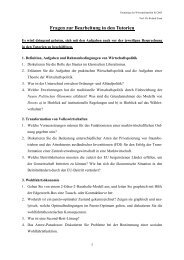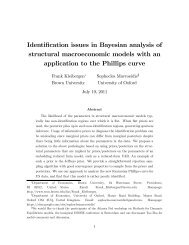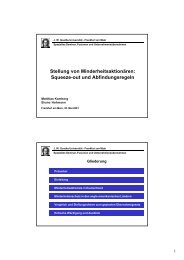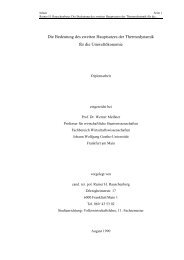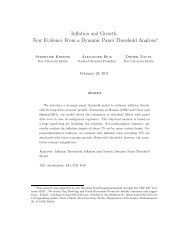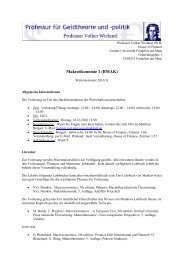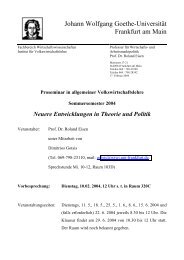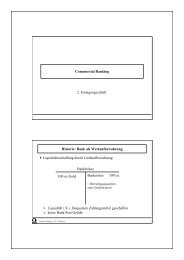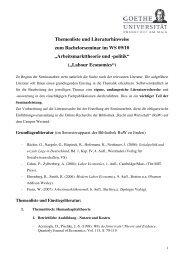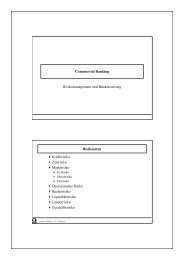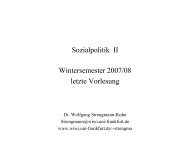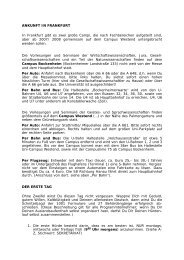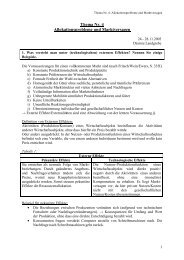Calvo vs. Rotemberg in a Trend Inflation World - Wiwi Uni-Frankfurt
Calvo vs. Rotemberg in a Trend Inflation World - Wiwi Uni-Frankfurt
Calvo vs. Rotemberg in a Trend Inflation World - Wiwi Uni-Frankfurt
Create successful ePaper yourself
Turn your PDF publications into a flip-book with our unique Google optimized e-Paper software.
<strong>in</strong>‡ation to 1984:I-2008:II U.S. macroeconomic data. Several …nd<strong>in</strong>gs arise. First,<br />
models acknowledg<strong>in</strong>g a positive trend <strong>in</strong>‡ation rate display a better (or, at least,<br />
no worse) …t than a basel<strong>in</strong>e "zero <strong>in</strong>‡ation <strong>in</strong> steady state" framework. Given the<br />
di¤erent policy implications stemm<strong>in</strong>g from a trend <strong>in</strong>‡ation-equipped framework (as<br />
opposed to the basel<strong>in</strong>e model) <strong>in</strong> terms of optimal policy and determ<strong>in</strong>acy of simple<br />
monetary policy rules (Ascari and Ropele, 2007, 2009), our results push towards the<br />
employment and development of macroeconomic frameworks consistently account<strong>in</strong>g for<br />
a positive steady-state <strong>in</strong>‡ation rate. Second, the U.S. data support <strong>Calvo</strong> (as opposed<br />
to <strong>Rotemberg</strong>) as the better …tt<strong>in</strong>g pric<strong>in</strong>g scheme. In particular, when compar<strong>in</strong>g<br />
the two models under the "no price-<strong>in</strong>dexation" restriction, we verify the rejection of<br />
the <strong>in</strong>dexation hypothesis by the <strong>Calvo</strong> framework. Interest<strong>in</strong>gly, this result emerges<br />
<strong>in</strong> absence of any stochastic model for the low frequency of the <strong>in</strong>‡ation rate, i.e.<br />
without appeal<strong>in</strong>g to any exogenous process model<strong>in</strong>g the possibly time-vary<strong>in</strong>g trend<br />
<strong>in</strong>‡ation as <strong>in</strong> Ireland (2007) and Cogley and Sbordone (2008). Di¤erently, shutt<strong>in</strong>g<br />
down <strong>in</strong>dexation <strong>in</strong> the <strong>Rotemberg</strong> framework leads to a drop <strong>in</strong> the model’s empirical<br />
…t, suggest<strong>in</strong>g a lack of <strong>in</strong>ternal dynamics <strong>in</strong> comparison to <strong>Calvo</strong>. Third, conditional<br />
on estimated (as opposed to calibrated) frameworks, the determ<strong>in</strong>acy area is shown<br />
to be strongly dependent on the choice of the price sett<strong>in</strong>g model. In particular, the<br />
set of implementable simple rules conditional on our estimated New-Keynesian model<br />
under positive trend <strong>in</strong>‡ation and <strong>Calvo</strong> price sett<strong>in</strong>g is substantially smaller than<br />
the one associated to the New-Keynesian framework derived under the standard zero<br />
steady-state assumption, and even smaller than that implied by the widely employed<br />
<strong>Rotemberg</strong> framework. Our empirical results po<strong>in</strong>ts toward the <strong>Calvo</strong> mechanism as<br />
the better …tt<strong>in</strong>g pric<strong>in</strong>g scheme. Thus, from a policy standpo<strong>in</strong>t, they suggest that<br />
policymakers should refra<strong>in</strong> from loosen<strong>in</strong>g monetary policy and stay hawkish, i.e., they<br />
should keep react<strong>in</strong>g strongly to the evolutions of the <strong>in</strong>‡ation rate.<br />
3



